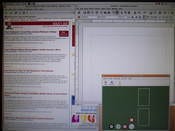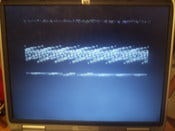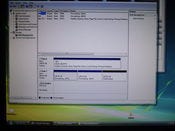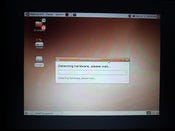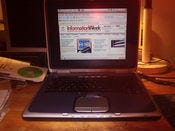The wildly popular Linux distro isn't all it's cracked up to be, especially if you try to install it on a laptop, our reviewer Alex Wolfe finds. Come along on his Ubuntu safari, as he hacks his way through bug-fraught installation attempts.

|
|
|
|
I started my Linux journey wanting to like Ubuntu. It's pitched as a great operating-system option that's ideal for newbies and experienced PC users alike. Ubuntu founder Mark Shuttleworth is, like Bill Gates, both an entrepreneur and a philanthropist. And there's something appealing about joining a community that's built up such a robust ecosystem in so short a time (Ubuntu was introduced less than three years ago.) What could go wrong?
Unfortunately, none of the Ubuntu stories--no Linux reviews, for that matter--talk about the inevitable problems many people run into during the installation process. Yet online forums are rife with traffic on stumbling blocks, which often cause people intent on converting to the open-source operating system to give up and go back to Windows.
|
|
| |
|
Things go most smoothly when you pick the plainest of plain vanilla desktops for your Ubuntu install. Selecting anything else--like the reasonably standard HP laptop I chose--could be an invitation to a software nightmare. Sadder still, the average homebrew Linux newbie will falsely feel that it's his technical ignorance that's the problem.
By now, you can guess what my conclusion is: Ubuntu isn't all it's cracked up to be. Indeed, if you're an individual user--and even more so if you're supporting an enterprise--the only path around problems is to use a heavily tested, commercially supported distro. My preference is SUSE Linux Enterprise Desktop 10 (though Red Hat is probably fine, too). I don't doubt that many fanboys will take issue with this (leave your comments below), since you'll have to pay $50 for SLED 10, and that's counter to the "free" open-source ethos.
Now that I've told you where I'm going, let me show you how I got there. Come along on my Ubuntu safari.
My test bed was an average machine, picked at random from the computer detritus lying around the house. The salient detail for our tale is that it's a laptop, not a desktop. Notebooks are always harder to work with, whether you're talking Linux, Windows, or hooking up add-on hardware. That's just a fact of life, because of the unusual variety of specialized drivers and hardware permutations you'll often find in downsized systems.
Preparing For Liftoff
My laptop guinea pig was an HP Pavilion ze4200 laptop, running Windows XP, purchased new in January 2003. The 6.6-lb laptop has a 14.1-inch display and is powered by a 1.53-GHz Athlon XP-M 1800+ processor. It's also got 256MB of DDR SDRAM, a 20GB hard drive, a DVD/CD-RW drive, and two USB 1.1 ports. While this might seem like a light configuration today, it's more than capable of running Ubuntu. The 20-GB drive is well above Ubuntu's 4-GB disk-space requirement. The 256-MB of memory exceeds the 64-MB minimum posted on the main Ubuntu installation page, though it only just meets the minimum spec on the 7.04 release notes, so I'm primed to accept a slightly longer installation time.
True, my HP laptop has nowhere near the heft of the four systems Dell is offering with Ubuntu. Dell's machines include two notebooks--the 1.73-GHz Core 2 Duo-based Inspiron E1505 N and 1.5-GHz Core 2 Duo Inspiron 1420 N--and two dual-core-based desktops, with 1.6-GHz and 1.8-GHz Intel processors.
When I requested a review unit from Dell in June, they said they didn't have anything immediately available. (Dell's reps recently told me they should have a tester available in about a month. I'll review it then.) That's when I decided to install Ubuntu out on my own machine.
One implicit message in all the hoopla surrounding Dell's embrace of Ubuntu is the notion that opting for Ubuntu is a no-brainer, not only for the direct-PC powerhouse, but for Windows users, too. It's pretty clear from all the press that it's widely assumed not much tuning was required to fit the Linux distro to Dell's hardware.
I won't know for sure until I test its system, but I believe Dell had to do some tweaking, probably by adding drivers, tuning the Ubuntu install options, and working around some of the bugs I found. (For my HP laptop, these included ACPI handling issues and false CPU-overheating shutdowns.)
|
|
| |
|
Regardless, unless you have a standard desktop with an already partitioned hard drive (more about that later), the point is that you may have to do significant tweaking to get Ubuntu to install and run smoothly.
The first step in the installation process is to go the Ubuntu site, so you can download and burn an ISO image of the OS onto a DVD. I selected the most recent version of Ubuntu, which is officially designated 7.04 but often referred to by its code name, Feisty Fawn. An image is a complete copy of everything you need to put onto a disk, so you don't need to figure out which files have to dragged and dropped into your burning program. The resulting Ubuntu DVD is used to boot your system and start the install.
I was psyched to get my laptop up and running Linux in short order. That's because the What is Ubuntu? page promises: "Everything you need on one CD, which provides a complete working environment. . .The graphical installer enables you to get up and running quickly and easily. A standard installation should take less than 25 minutes. . .Once installed your system is immediately ready-to-use."
That didn't turn out to be the case. The download of the 697-MB Feisty Fawn image took me 40 minutes. (This was via my Roadrunner "high speed" cable-modem access at home. At work, where the link operates close to its 1-Mbps capability, the download took 18 minutes.)
Slow-Starting Install
With Ubuntu ISO image disk in hand, I fired up my HP laptop. I pressed "escape" and changed the boot order so that it'd look to the CD drive first. However, after I hit "return" in response to the "Start or install Ubuntu" request, I was faced with a blank screen for the better part of 10 minutes. There was no indication of whether the installation was proceeding, other than the fact that my CD-ROM drive's light continued to flicker.
Whatever you may think of the advertorial "tips" Windows displays during installation, they at least let you know that everything's running okay. Moreover, since the Microsoft "screen of death" paradigm--blue, with XP and earlier OSes, black, with Vista--has trained us to view blank as bad, Ubuntu would be better served by playing to our expectations and putting something informative up on the display. I was treated to a logo, beneath which lurked an activity bar. Mostly, though, I had to check the CD drive's light to verify that the system was still loading.
The "Start or install" message is itself misleading. (I know, old Linux hands will say Ubuntu newbies should read the documentation.) Selecting this option doesn't initiate an installation. Rather, Ubuntu loads onto your machine without installing. It's getting itself up and run off of the disk, which is called the "Live CD."
|
|
| |
|
The installation can begin only after the Live CD is running. At that point, installation is commenced by double-clicking on the install icon in the upper-left quadrant of the screen. However, if you can't successfully load the Live CD, you can't install Ubuntu.
That was my problem. After 15 minutes, a white box appeared in the upper left portion of the screen, and a nonspecific, 2-second sound came and went. More churning away, and after two more minutes an ominous message appeared:
"There was an error starting the GNOME setting daemon. Some things, such as themes, sounds, or background settings may not work correctly. GNOME will try to restart the Setting Daemon next time you log in."
You've got to love Linux. I haven't encountered the word "daemon"--a Unix-era term for a background process--in years. Perhaps that's why I took the message as an indication that it was time to shut down the install attempt.
All told, I had spent a good deal more than Ubuntu's promised 25 minutes to work my way through an unsuccessful installation. More problematically, in failing to install itself successfully, Ubuntu also screwed up the OS I already had on the system. After shutting down, removing the Ubuntu install disk, and restarting, the laptop was unable to load Windows XP.
Kubuntu Calling
Not wanting to back down from my review, nor reinstall Windows XP, I decided to follow up the failure of the Feisty Fawn install by taking a crack at Kubuntu. The OS is the same as Ubuntu expect it's fitted with the KDE desktop instead of GNOME. KDE is often characterized as more complex than GNOME, but mostly they're just two different approaches to the same thing. (Articles contrasting the two are available here and here. There's also a discussion thread from 2006 on the Ubuntu forums.)
|
|
| |
|
I wonder if the Linux newbie to whom Ubuntu is pitched would think of trying Kubuntu next? That's another bone I have to pick with the Ubuntu community. True, installation glitches are common occurrences, whether you're talking Windows or Linux. However, since Ubuntu is pitching itself as a Linux panacea for new users, you'd think its installation guide would offer more hand-holding. For one thing, the main Ubuntu 7.04 help page doesn't link to installation notes. Perusal of the Community Documentation page quickly turns up a guide. However, it's a pro-forma walkthrough of the obvious stuff, with no troubleshooting tips. The 7.04 release notes do mention several bugs, but the notes seem of little value to newbies.
A key argument here is that I'm far from the only one who's had problems getting Ubuntu running. A check of the heavily trafficked Ubuntu forums turns up a long list of incompatible hardware. A search also reveals numerous messages seeking advice on how to right broken installations.
A point about the forums: They're the best feature of the Ubuntu ecosystem, and speak to a promising future for the OS, assuming its supporters begin to seed more realistic expectations in potential users. Notwithstanding Ubuntu's current efforts to appeal to inexperienced users and new Linux converts, the site's message boards are trolled by many highly experienced people.
The Ubuntu message boards gave me support, by showing me that many others were going through the same travails in their installs. They also helped me come up the learning curve very quickly, and ultimately enabled me to get Ubuntu going.
First, though, I took the Kubuntu detour, which also resulted in my first success. It took another 30 minutes to download the Kubuntu ISO image and burn the DVD. However, Kubuntu loaded and ran successfully from the Live CD. This indicated to me that there was something in the HP laptop's graphics subsystem that Ubuntu's GNOME desktop didn't "like." (That observation correlated with Ubuntu forum message traffic I found later on.)
Great, I'm halfway home, I thought, as I clicked on Kubuntu's install icon. However, it was not to be. Kubuntu made it through the screens asking me to select a language, time zone, and user name, but it bombed out when it started partitioning my hard drive.
Back To Ubuntu
Now I was really getting frustrated. However, since I'd invested a fair amount of time, I was determined to see things through. The notion that the HP laptop "liked" Kubuntu's KDE but not Ubuntu's GNOME led me back to the Feisty Fawn DVD. This time, I selected "Start in safe graphics mode." Things did not go well. So it wasn't surprising that this safe-mode attempt resulted in a fritzed out screen, displaying an illegible text message or logo.
That was followed by a blank white screen and then a message to "Please remove the disc, close the tray, and press ENTER to continue." The display went dark, the system restarted, and it attempted to (unsuccessfully) boot XP.
Now I was totally flummoxed. However, determined to suffer so that you don't have to, I turned to the Ubuntu forums. Searching through the message traffic turned up lots of cases of similar problems:
"On my HP laptop, the display won't work at all."
From the Ubuntu Forums, here.
A beginner's frustration with Ubuntu.
Also on the Ubuntu Forums.
Formatting a Linux ext3 disk partition on Ubuntu takes a long time. Ubuntu Forum message, here.
Pavilion laptop freezes with Kubuntu.
On the Kubuntu Forums. Adding the "noapic" command to the boot options appears to help.
Crashing during disk partitioning
This has risen to the level of a "confirmed" bug, according to Launchpad.
Ubuntu desktop incompatibility list.
It's a very long list, here.
|
|
| |
|
A site called Linux on HP Laptops offered an anecdotal angle on my installation challenge. It's a non-HP site, containing a lengthy list of HP laptops along with reader-submitted links suggesting a Linux distro that's appropriate for each model. (A lot of the links are broken, but many aren't.) Gentoo is listed next to my HP ze4200, a tacit suggestion that perhaps it's not a good candidate as an Ubuntu box.
One user summed up the Zeitgeist of frustrated Ubuntu users everywhere with his post, entitled: "Ready to throw in the towel on Ubuntu":
"Sorry, guys, but I've about reach my limit of frustration using Ubuntu 7.04 Feisty. I may be a "n00b" by Linux standards, but I'm not new to personal PCs, nor am I new to computers in general -- which is another way of saying I expect setbacks in trying out something new. And, OK, I shouldn't have believed the hype about Linux being crash-free and worlds better than Windows, but I really wanted that to be true -- really!!"
A little wiser about what to keep an eye out for, I resumed my Ubuntu safari. The haphazard problem-diagnosis sequence I went through could admittedly have been improved with some more forethought. However, I think it's illustrative of the problems that most computer users go through, in that the deeper you dig into something, the harder it becomes to see your way clear to the end.
The next several hours were a blizzard of false starts and stops. Here's a fast-forward summary of how I reached the point where I was finally poised to successfully install Ubuntu on my laptop:
1) I decided to turn to the Ubuntu Alternate CD. That's another version of the OS, which offers text-mode installation options intended for use in tricky situations. After another 30 minutes to download the image, Ubuntu Alternate worked itself partway through a text-mode install, but then detected what it claimed was an overly hot processor and did a "critical temperature reached, 128 C, shutting down." It turns out that this is a frequently reported problem, according to the Launchpad bug site.
2) Figuring maybe it was me and not the Ubuntu (what's a twenty year old engineering degree worth, anyway?), I decide to install Ubuntu on my white-box desktop. There's nothing special about this machine except it has a fairly decent processor in the form of a 3.2-GHz Intel dual-core Pentium D 945.
|
|
| |
|
3) Ubuntu Live CD loaded like a champ on the desktop, but it wouldn't install! (^%*$#!!!!) Turns out it didn't "like" having a huge, unpartitioned 500-GB SATA hard drive at its disposal.
4) Using Windows Vista's very slow disk-management tool, I created two 160-GB NTFS partitions on the drive, leaving one free 160-GB partition, which I intended to use as the ext3 allocation in which Ubuntu could be installed. (Vista's tool can't actually create an ext3 partition, because that's normally used as Linux file system, so I left it blank for the Ubuntu installer to take care of.)
5) With the disk mostly formatted, I successfully fired up and installed Ubuntu on my desktop. I have to say it's not bad, though I still like both Vista and Novell's SLED 10 better.
6) Back to the HP laptop. I was now working under the assumption that its installation problem revolved around Ubuntu "wanting" to see a partition it could load the OS into, I grabbed the Kubuntu DVD. (I couldn't use the Ubuntu disk, because that wouldn't load even in Live CD mode.
7) I loaded Kubuntu in Live CD mode, so that I could access the GNOME partition editor, a disk-partitioning utility which is included as one of its system applications. Fortunately, this is a GUI version of GParted, not the difficult-to-use text-mode version you get if you download it as a standalone utility.
8) Using GPartEd, I created 3 partitions on my HP laptop's hard drive.
9) Back to the Ubuntu DVD. I tried the regular "start and install," with no joy.
10) I reloaded the Ubuntu DVD, and tried "start in safe graphics mode."
This worked! However, at this point I still only had the Live CD up and running. I double-clicked on the install icon, expecting success. However, it still didn't like the partitions I had set up and wouldn't load.
So it was back to Kubuntu and the GNOME partition editor, where I mucked with the partitions. By this point—remember this is a warts-and-all review—I was so frustrated that I diverted from my plan to set up nice partitions and started trying whatever I could get to work.
Finally Difficulties
Mostly, this was forced on me because GPartEd wouldn't let me cleanly resize the drive partitions on the HP laptop. I wanted to make the reinserfs partition small and create a big ext3 allocation so I'd have ample room for Ubuntu, notwithstanding the fact that the basic OS requires about 2 GB of disk space. (Take that, Windows Vista!). Ultimately, I was only able to allocate a 5-GB ext3 partition.
|
|
| |
|
Fortunately, this tiny swatch of disk space was enough to successfully install Ubuntu on the HP laptop. With Ubuntu installed, the system booted up correctly (yes, with the CD removed).
However, there were still several problems. Most annoying was that the Ubuntu desktop did not use the full display. It was compressed, as if it had installed itself in safe-graphics mode. (I assume that, having solved the partition problems, I could have gotten Kubuntu to install at full-screen width, but I didn't have the energy to try it.)
More annoying, the installation was unstable. It frequently shut itself down after posting the "critical temperature reached" message. (This is a known bug.) Given the existence of the bug report, and the fact that Windows XP didn't shut down at far hotter case temperatures, I'm confident my laptop wasn't actually overheating.
The upshot is, the long and tortured installation process I went through taught me a lot about the difference between Ubuntu perceptions and reality. Many Linux supporters may feel that free distros of the open-source operating system should be more widely adopted. However, until they become both more robust and simpler for everyday users to contend with, they'll remain outside the mainstream. For now, I simply can't recommend Ubuntu over a commercially supported option like Novell's SUSE Linux Enterprise Desktop 10, even if the latter costs $50, Because after all my Ubuntu difficulties, I installed SLED 10 on the HP laptop without a hitch.
Useful Links:
About the Author(s)
You May Also Like




